
Getting from Haneda Airport to Madarao Kogen
Map
There are many different routes for getting from Haneda Airport to Madarao Kogen. If it is your first time to Madarao Kogen , or you have a lot of luggage, then you may be better off using a direct service like the Nagano Snow Shuttle.
Below we summarize the easiest route to Madarao from Haneda Airport by Public Transport. If you’d like advice on other routes, please do not hesitate to send us an inquiry.
Haneda Airport
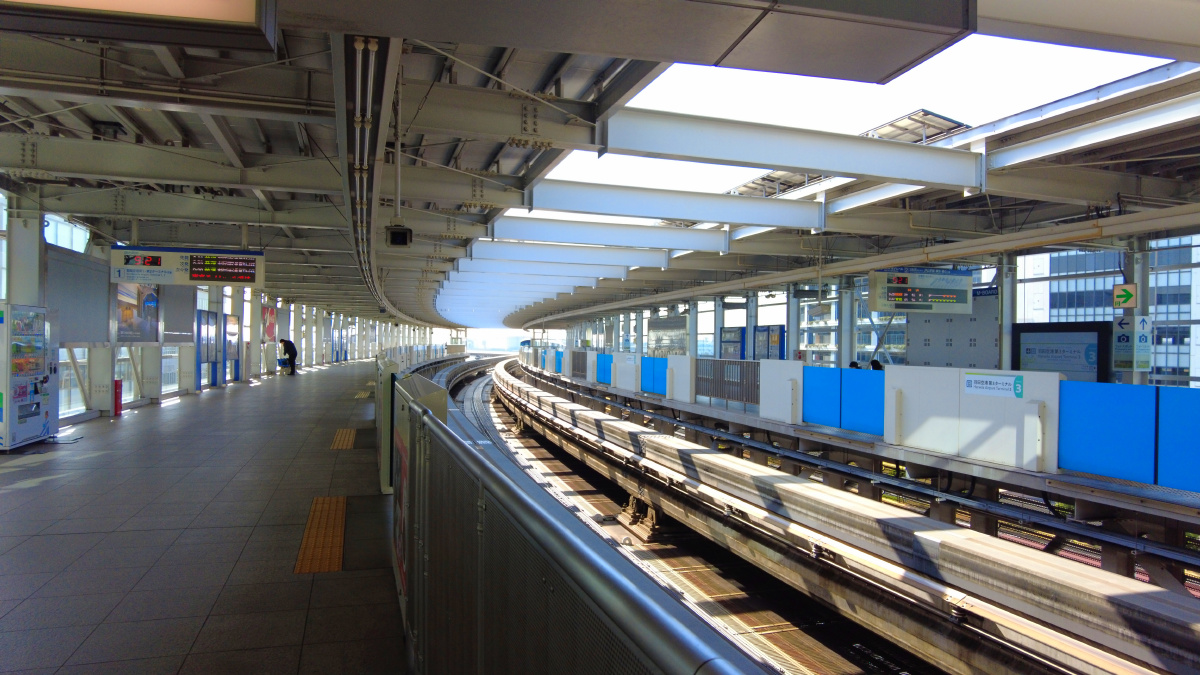 This route uses the Tokyo Monorail to get to Hamamatsu-Cho Station, then a local train to Tokyo Station, followed by the Shinkansen Bullet train to Nagano, and Bus to Hakuba Valley
This route uses the Tokyo Monorail to get to Hamamatsu-Cho Station, then a local train to Tokyo Station, followed by the Shinkansen Bullet train to Nagano, and Bus to Hakuba Valley
Haneda Airport Terminal 2
The Tokyo Monorail Station is located on the B1 level of Terminal 2. Terminal 2 is the origin and terminus of all Tokyo Monorail Services. The platforms are on level B2 and both platform 1 & 2 trains go to Hamamatsu-Cho.
Haneda Airport Terminal 1
The Tokyo Monorail Station is located on the B1 level of Terminal 1. The platforms are on level B2, and platform 1 trains go to Hamamatsu-Cho.
Terminal 3
You can access the Tokyo Monorail Station from the 2nd (arrivals) or 3rd (departures) floors at Terminal 3. Platform is on level 3, with platform # 2 being for trains heading to Hamamatsu-Cho.
Buying a Ticket
The Tokyo Monorail and JR are separate companies, so you need to buy different tickets. Good news is that you can buy both at the airport. First go to the Monorail Station and purchase a ticket to Hamamatsu Cho (Fare is currently 500yen). Then head to the JR Service Center and purchase a ticket from Hamamatsu Cho to Iiyama.
By the time you board the train, you will have a handful of tickets. All you need to do is keep the monorail and JR tickets separate.
Boarding the Train
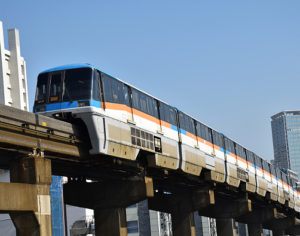
Put the Monorail ticket into the ticket gate and it will pop out halfway down the gate. You must take your ticket as you need it at Hamamatsu Cho to exit the station there. Go to the platform and board the train.
Note that there are 3 different types of train on the Tokyo Monorail Line.
- Haneda Express trains only stop at the 3 Airport Terminals then head directly to Hamamatsu Cho without stopping. These trains take as little as 13 minutes to cover the trip
- Rapid Trains stop at 3-4 stations between Terminal 3 and Hamamatsu Cho. The trip take about 15 minutes
- Local Trains stop at every station en-route. These trains can take up to 20 minutes to cover the full trip.
The Trip
The seats in the monorail are facing in all directions, and during busy periods you may not get a seat but have to stand. There are smallish luggage areas on board, but due to the short nature of the trip, many people just keep their luggage with them.
Transfer at Hamamatsu Cho Station
On arrival at Hamamatsu Cho, you get off the left hand side of the train. Don’t lurk too long as the doors on the right hand side open about 30 seconds after arrival and people going back to the airport get on board.
At Hamamatsu Cho Station you transfer to the JR lines. If you have tickets already, then you can use the dedicated transfer gates. If you do not have tickets, then you just exit the ticket gate, swing right and go to the JR ticket counter and purchase tickets.
Once you have your tickets, insert into the ticket gate, and retrieve them as you walk through. Head to platform # 1 or #2 (both are the same platform). All trains from platform 1 &2 go to Tokyo Station. Platform 1 is the Keihin Tohoku Line, while platform 2 is the Yamanote Line. Only commuter trains run on these lines, so you may not get a seat during rush hour.
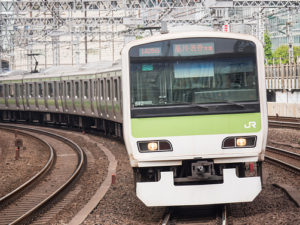
Trains from Hamamatsu-Cho to Tokyo Station leave from platform 1 & 2. All trains on this platform will make a stop at Tokyo Station.
Theese trains are standard commuter trains, so can be quite busy during rush hour.
The trip from HamamatsuCho to Tokyo Station only takes about 8 minutes.
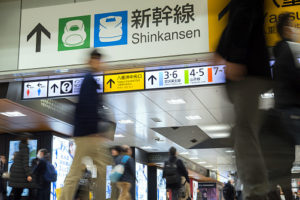
Tokyo Station is massive, and is the 3rd busiest station in Japanese with nearly 500,000 people daily.
On the main concourse level there are 10 platforms for commuter and express trains, and 10 platforms for Shinkansen Bullet trains.
There are also basement platforms (4) and a further 2 platforms for the JR Keio Line. Add in a couple of subway stations and you get the picture.
Rush hour here can be mayhem!
At Tokyo Station you will arrive at platforms 3 or 4 (these both share a platform). The platforms are on level 2, and you need to go down to level 1 to transfer to the Shinkansen Bullet train.
The Shinkansen have an extra set of ticket gates. You need to put your tickets into the machine before you can pass through (always remember to collect your tickets as they pop out part way through the gate).
Once through the gates you’ll see a lot of digital signs that flick between English and Japanese. They will show the Train Name, Departure Time and Platform Number. Locate your platform and take the escalator up.
Hokuriku Shinkansen via Nagano

Train Classes
There are several classes on the Hokuriku Shinkansen.
- Standard Class (reserved and non reserved*) – 5 seats across the row in a 3-2 configuration (Cars 1-10)
- Green Class (superior class) – 4 seats across the row in a 2-2 configuration (Car 11) – Green Class costs about 20% more than standard class
- Gran Class (first class) – 3 seats across the row in a 1-2 configuration (Car 12). Complementary food and beverage service (Kagayaki and Hakutaka trains only) – Gran Class costs about double of standard class
- reserved seat means you have an assigned seat / non-reserved means you can sit in any seat in a “non-reserved” carriage (first come first seated basis)
Train Types
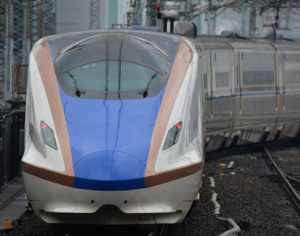
The only trains that stop at Iiyama Station are called “Hakutaka”. You cannot take the “Kagayaki” or the “Asama” trains to Iiyama.
You also need to check carefully if your train does make a stop at Iiyama, some Hakutaka trains do not.
Iiyama is the stop after Nagano.
The trip from Tokyo to Iiyama takes just under 2 hours.
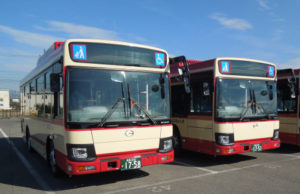
Bus to Madarao Kogen
There are several different bus lines operating between Iiyama Station and Madarao.
- Community Bus #1
This bus has 5-6 services per day between Iiyama station. This is the slowest bus as it stops many times. Cost is 500yen per adult - Express Bus #14
This is the fastest bus that runs to Madarao Kogen Hotel and Tangram also. There are only 2-3 buses a day. Cost is 700yen to Madarao Kogen Hotel, and 1,000yen to Tangram - Notoma Bus #22
This is the bus from Nozawa Onsen to Madarao Kogen that runs via Iiyama Station. This is mainly a bus for day trippers, so there is one bus in the morning, and one in the late afternoon. Fare is 700yen - Express Bus #25
This bus runs twice a day from Iiyama Station to Madarao Kogen Hotel. Cost is 700yen per person
Buying Tickets
There is a vending machine inside Iiyama Station right before you exit the building. Coming down the escalator, head to the furthermost exit door and you’ll see the vending machine in the corner. It only takes cash. If you don’t have cash then head to the Seven-Eleven close to the station (exit the station on the Chikumagawa Exit and turn right. Follow the train line south for 1 block and you see the seven-eleven). The Seven Eleven has an international ATM.
Boarding the Bus
The buses leave from bus stop #1.
Arrival in Madarao Kogen
All the buses stop at Yama-no-ie (Information Center), Plaza Mae, Madarao Kogen Hotel. Ask you accommodation which bus stop is closest. Only bus #14 goes as far as Tangram.
If your host has a pick up service, then call them when you leave Iiyama Station and let them know which bus you are on, and which bus stop you will be disembarking at.
